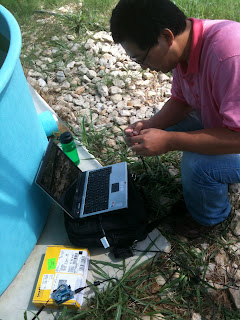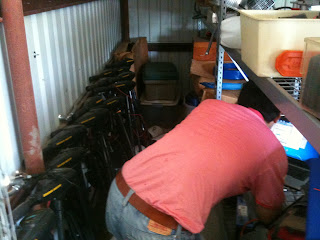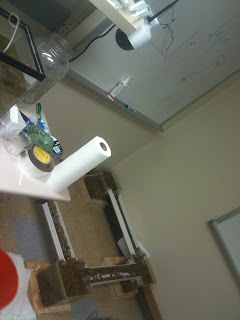Today was another field day for use. We went out and met Dr. Hoenghaus and Luke at the Water Treatment Facility to set up our WSN and start logging data. We got our sensor cluster anchored and set up quickly.
We did take a second to calibrate the DO sensor, but it was pretty simple.
It took a little bit longer to get the YSI Sonde calibrated and set up. This time we used a more high end model that has a longer battery life and can stay in the field longer. It also has more ports for probes. This one is equipped with a pH, DO and temperature probe but also includes a turbidity probe.
The probe that Dr. Hoeinghaus is pointing at here is the Turbidity probe. The rollers are sponges that clean the probe so nothing gets caked on to the sensor. Once it was calibrated when dropped everything in the water together so we would have data that we could compare.




The original plan was to just log two hours of data and then bail. Luke and Dr Hoeinghaus planned on being at the facility all day today and tomorrow, though, and Yixing was ok leaving his computer over night so we made an executive decision in the field and decided to let the probes run until the morning. That is exciting because it increases the likelihood of getting changes in DO and pH since the temperature will almost certainly change. Since we are leaving things in the field we needed to set up the laptop somewhere protected. Putting it in the shed seemed like the best option but we were concerned about the signal. Joe set up an antennae on the wall of the shed with the lead heading through a small hole in the wall and Yixing set up his laptop inside.
The other big piece of news was that the camera is up and running, We rigged it up on a cross bar and accessed the signal using Yixing laptop and let Luke and Dr. H play. They were very excited by the possibilities.
Back on campus we had several more successes. I completed the activity we are going to use at TechFest and got approval from Joe and Lori while Joe made some great progress with the paper. Yixing also produced schematics for our circuit that we can include in our paper.
 |
| DO Circuit |
 |
| Temp Circuit |
 |
| pH Circuit |
 |
| Power Circuit |
 |
| Complete Circuit |
That's not all, though. Yixing also created a website that automatically translates the data tables produced by the data sink into a visual format.
Pretty exciting stuff! Once we get the data from the sondes and the sensor cluster we can start checking to see how accurate our system is. We will keep you posted. If you are interested in an update on the fish in the artificial stream... sadly, we are down to 11. We had a couple of floaters this morning and most of the smaller fish are gone.

.JPG)
.JPG)
.JPG)
.JPG)
.JPG)

.JPG)
.JPG)
.JPG)








































.JPG)
.JPG)

